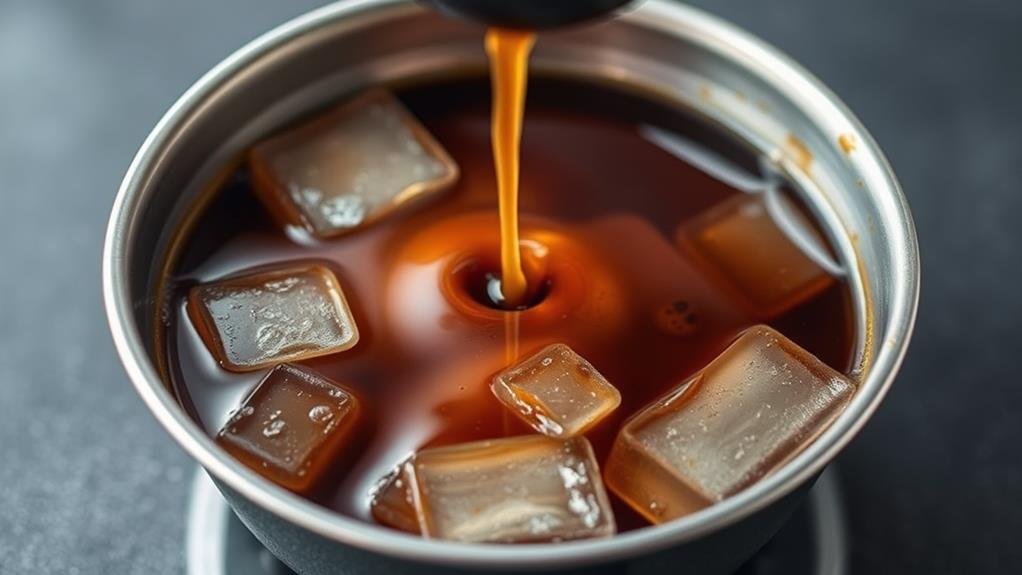Did you know that over 70% of coffee enthusiasts are open to trying new and innovative brewing methods? Making clear coffee is one such trend that has gained significant attention lately. While traditional coffee is rich and full-bodied, clear coffee offers a unique aesthetic appeal while retaining the flavor profile. If you're curious about how to achieve this transparent brew, you're in luck. I'll be exploring several methods, from agar agar clarification to distillation processes, each designed to remove impurities and solids from your coffee. Let's start with the basics and see which method works best for you.
Grinding and Steeping Process

To begin making transparent coffee, you need to focus on the grinding and steeping process. First, grind your coffee beans to a medium-coarse consistency. This grind size is essential for ideal extraction during steeping. You can use either a French press or an immersion brewer for the steeping process. Both of these methods involve steeping the ground coffee in hot water.
Next, consider the steeping time, which typically ranges from 4 to 8 minutes. The exact time will depend on how bold you prefer your coffee. If you're using a French press, you'll need to gently press down the plunger after the steeping time is up to separate the grounds from the clear coffee.
Adjusting both the steeping time and the grind size allows you to control the clarity and flavor intensity of your final product. For example, a longer steeping time will result in a stronger, more intense coffee, while a shorter time will yield a lighter brew. By paying attention to these details, you can achieve consistent results and customize your coffee to your taste preferences. This cautious approach guarantees that each cup of clear coffee meets your standards.
Agar Agar Clarification Method
To clarify coffee using the agar agar method, I start by preparing the agar agar solution. This involves dissolving the agar agar powder in hot water to create a gel-like substance. Once prepared, I proceed with the clarification process, which involves mixing the agar agar solution with the coffee to remove impurities and achieve transparency.
Agar Preparation Steps
When it comes to making clear coffee using the agar agar clarification method, the first step involves preparing the agar agar mixture. This process is important for achieving a transparent and flavorful coffee without the need for filters.
To start, dissolve the agar agar powder in a quarter of your coffee batch by boiling it completely. This makes sure that the powder is fully incorporated and no lumps are formed.
Here are the key steps to follow:
- Dissolve Agar Agar: Boil a quarter of your coffee with agar agar powder until it's fully dissolved.
- Combine Mixture: Add this hot agar-agar mixture to the remaining cold coffee to prevent premature gelling.
- Allow Setting: Let the mixture set without stirring to maintain the agar agar's gelling properties.
- Clarify Coffee: The gelled mixture will help clarify your coffee, retaining its original flavors while achieving transparency.
Clarification Process
The clarification process begins once the agar agar mixture is fully incorporated into the coffee. This method leverages agar agar, a gelling agent derived from seaweed, to achieve clear coffee efficiently. Once mixed, the agar agar quickly gels, which is pivotal for the clarification process. Unlike some other methods that require freezing and thawing, agar agar simplifies this step by eliminating the need for such temperature changes.
As the mixture gels, it rapidly sinks to the bottom of the container, carrying impurities with it. This fast gelation and subsequent sedimentation are essential to achieving clarity in coffee. The process is irreversible, meaning once the gel forms and settles, it won't dissolve back into the liquid, ensuring that your coffee remains clear.
One of the advantages of using agar agar for coffee clarification is that it retains the original flavors of your coffee while removing impurities. This makes it a popular choice among those seeking clear coffee without compromising on taste. Overall, the agar agar clarification method is effective and straightforward, making clear coffee more accessible than ever before.
Milk Clarification Technique

When using the milk clarification technique to make clear coffee, citric acid plays an essential role by curdling the milk and helping to separate the curds from the whey. This process allows for a clearer final product as it traps unwanted particles. Next, filtering the mixture through a nut milk bag effectively removes sediment and impurities, resulting in a smoother taste and clearer appearance.
Citric Acid Role
Citric acid is a game-changer in the milk clarification technique for making clear coffee. When it comes to achieving that crystal clear coffee, citric acid plays a pivotal role. Here's how it works:
- Curd Formation: Citric acid aids in curd formation, which is essential for pigment removal. This process helps separate the curds from the liquid in the cold brew coffee mixture.
- Reaction and Filtration: The addition of citric acid creates a reaction that assists in filtering out impurities, contributing significantly to the clarification process.
- Separation and Clarity: By filtering the cold brew coffee mixture through a nut milk bag after adding citric acid, you can achieve a much clearer final product.
- Final Product Quality: Without citric acid, achieving a fully clarified coffee would be notably more challenging. It helps extract and filter out impurities, resulting in a transparent and high-quality clarified coffee.
Using citric acid ensures that your coffee is not only clear but also free from unnecessary particles, making it perfect for those who want crystal clear coffee without the need for filter paper. This technique is straightforward and effective, making it easy to produce high-quality, clarified coffee at home.
Nut Milk Bag Filtration
Filtering through a nut milk bag is a crucial step in the milk clarification technique for producing clear coffee. This process involves heating milk with citric acid, which aids in breaking down the proteins and fats, making it easier to separate the solid particles. Once the milk has been heated, cold brew coffee and vanilla extract are added to create a mixture that requires clarification.
The mixture is then cooled down, allowing the curds to form and separate from the liquid. This is where the nut milk bag plays a role. By pouring the mixture into a nut milk bag, you can strain out the curds and pigments, achieving clarity in your coffee. The filtration process effectively eliminates impurities and pigments from the coffee, resulting in a somewhat cloudy but notably clearer final product.
Using a nut milk bag for filtration ensures that you end up with coffee that has been purged of many of its impurities, improving its clarity without compromising its flavor. This technique is one of several methods tested to create clear, colorless coffee by eliminating unwanted particles through meticulous filtration. By following these steps, you can attain a clearer coffee that aligns with your standards of taste and appearance.
Activated Charcoal Filtering
Activated charcoal filtering is a method I frequently use to eliminate impurities from coffee, including its pigment. This technique is particularly effective in achieving a colorless coffee by adsorbing impurities.
To use activated charcoal filtering, I follow these steps:
- Add Activated Charcoal: I include charcoal in milk clarified cold brew.
- Filter Through Brita: The mixture is then filtered through a Brita water filter.
- Remove Sediment: This process successfully eliminates charcoal residue.
- Final Result: The outcome is a clear and clarified coffee.
This method alters the appearance and taste of coffee, resulting in a clean and transparent final product. By incorporating activated charcoal into the filtration process, I can guarantee that the coffee is free from unwanted impurities. The end result is a clear coffee that maintains its clarity without any residual sediment. This technique is simple and efficient, making it an excellent choice for those seeking to create a unique and appealing beverage.
Freeze-Thawing for Clarity

After achieving clarity with activated charcoal filtering, I often turn to another effective method: freeze-thawing. This process involves freezing jellied cold brew in measured quantities for operational efficiency. By freezing the coffee, I can easily manage and store it, which is essential for maintaining consistency in the final product.
When I need to serve clear coffee, I simply thaw the frozen blocks daily. This results in freshly clarified coffee each time. However, it's worth mentioning that varying concentrations of coffee drips can occur due to melting ice crystals during thawing. To guarantee consistency, I mix these concentrated and lighter drips together.
The freeze-thawing method is particularly advantageous because it eliminates the need for filter paper in the preparation of clear coffee. This not only saves time but also reduces waste. The clarity and freshness of the coffee are preserved throughout the process, making it an ideal approach for those who prioritize both quality and efficiency. Overall, freeze-thawing is a reliable and efficient way to achieve clear coffee without compromising on taste or clarity.
Distillation Process for Clear Coffee
To achieve transparent coffee through distillation, I boil a water-coffee mixture to extract the essence of coffee in a colorless form. This process is quite unique and involves several key steps:
- Boiling the Mixture: The first step is to boil the water-coffee mixture thoroughly. This helps in releasing the volatile compounds and essence of the coffee.
- Separation: As the mixture boils, it undergoes separation, where the clear liquid is collected while impurities are left behind.
- Flavor Preservation: The distillation process focuses on preserving the flavor of the coffee while removing its color. This is essential for maintaining the taste profile of clear coffee.
- Color Removal: Similar to processes used for other beverages like clear chocolate, distillation for clear coffee ensures that all color is removed, resulting in a purely transparent liquid.
Through this distillation process, I can produce a clear coffee-like liquid that retains all the flavors of regular coffee without any of its color. This method, though not traditional brewing, offers a modern twist on how we enjoy our coffee. Synthesizing equivalent-tasting compounds is necessary here, balancing flavor extraction with color removal challenges to create an authentic clear coffee experience.
Conclusion
Making clear coffee sounds like a mission impossible, but with the right techniques, it's surprisingly achievable. From agar agar to distillation, each method requires patience and precision. Ironically, the most transparent coffee requires some of the most complex processes. However, the end result—flavorful and visually stunning—is well worth the effort. With these methods, you can enjoy a crystal-clear cup that defies expectations and pleases both the eyes and the palate.

